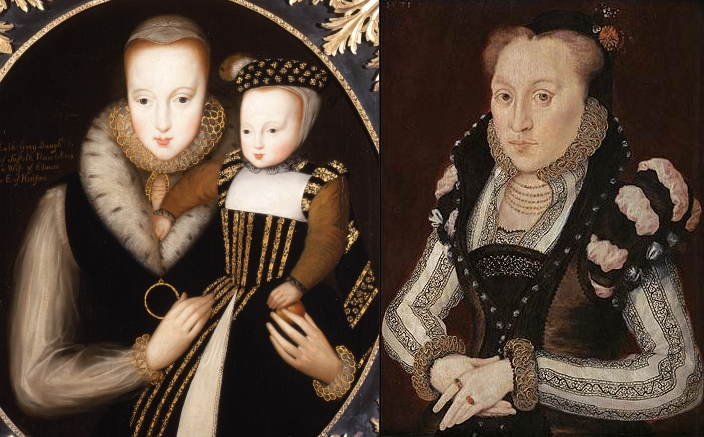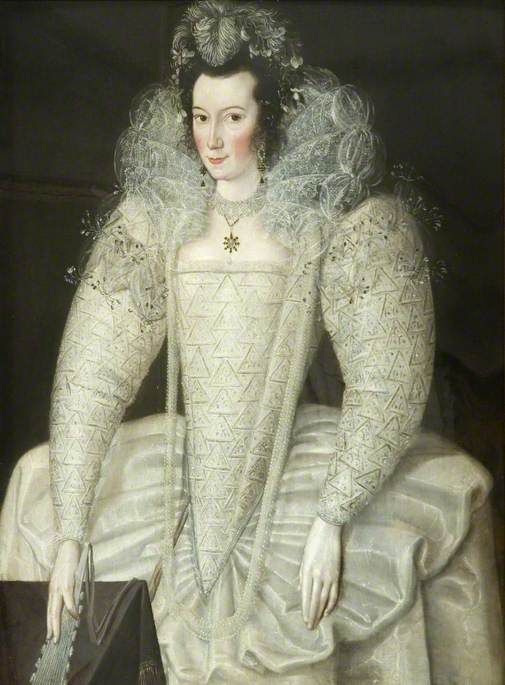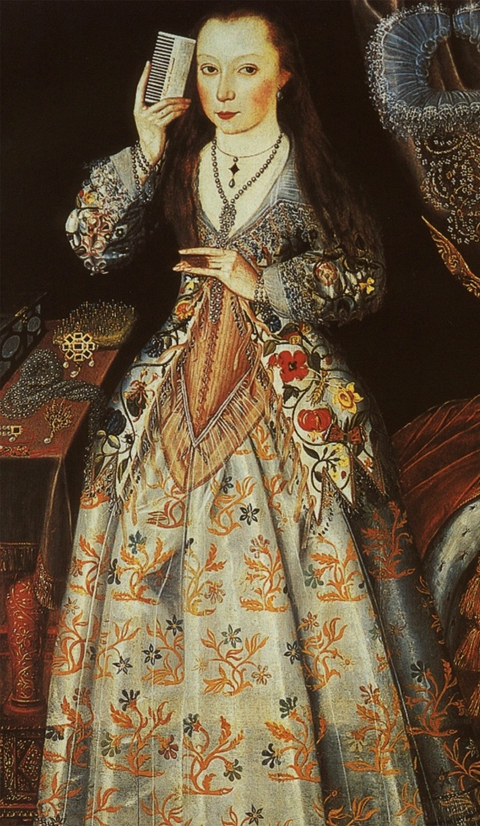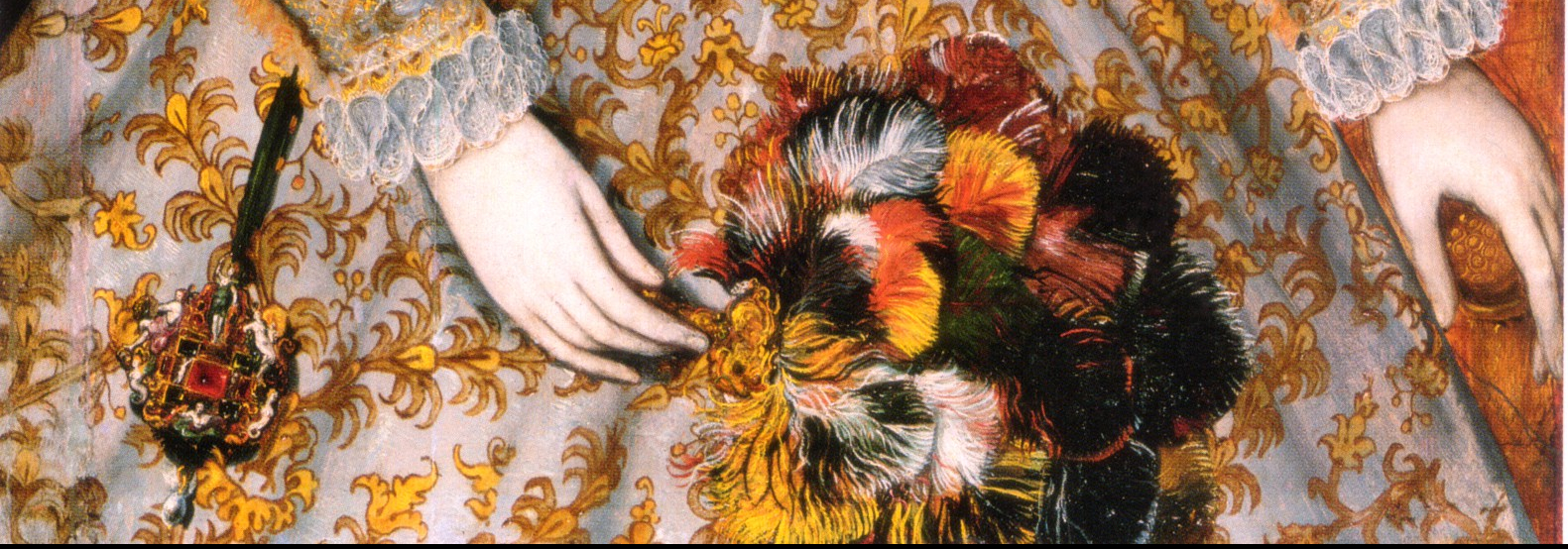While Elizabeth I’s reputation as the Virgin Queen has been in question since her own lifetime, the ladies around her certainly didn’t aspire to the virginal state, despite their mistresses repeated lectures on the matter. It’s not known exactly why Elizabeth shied away from taking a husband, though theories range from witnessing her father’s violently unsuccessful marriages, a fear of pregnancy, or for the political implications of raising a man above her to the throne. Whether personal or political, Elizabeth’s negative opinion of marriage did not just apply to her own and she was notoriously unimpressed by romantic dalliances among her ladies, unless it was she who had orchestrated them. Elizabeth demanded absolute loyalty, requiring her ladies to devote their time solely to their duties in her service, at the expense of family life. Ladies who left court to have children were expected to return as soon as they were physically able to, leaving the child with a wet nurse far from court. The Queen’s reactions to court romances were sometimes so extreme that many of those around here conducted their affairs, and subsequent weddings, in secret, only to suffer Elizabeth’s increased displeasure when the marriage was discovered. Towards the end of her reign her attendants were so concerned with marrying in secret that the Spanish ambassador remarked the Queen discovered a new match each week. Here are some of the more unfortunate women who incurred Elizabeth’s wrath through their choice of husbands, though I’ve left out the most obvious; Lettice Knollys who married Robert Dudley, solely because the relationship between Lettice, Dudley and Lady Douglas Sheffield is worthy of a piece all of its own.
Catherine and Mary Grey

Sisters to the doomed Lady Jane Grey; Catherine and Mary Grey had the potential to be thorns in Elizabeth I’s side from the outset of her reign. Catherine had initially been named Jane’s successor in the event that Jane died without male issue. To that end she was married to Henry Herbert, the heir to the Earldom of Pembroke, but the marriage was annulled after Jane’s execution and the family’s attempt on the throne had been defeated. Mary had been a small child at the time and although betrothed, had no involvement in the family’s dynastic ambitions.
Upon Elizabeth’s accession she was obliged to give them positions at court, though her dislike for the two potential heirs (under the terms of her father’s will), was well known. She especially disliked Catherine, who was, to all intents and purposes, a younger and prettier version of herself. Catherine hardly helped matters by being openly critical of the Queen, but politics would force them together when Elizabeth awarded the Grey sisters with prestigious positions at court, in response to Mary, Queen of Scots claim to the English throne.
It was around this time that Catherine became involved with Edward Seymour, Earl of Hertford. The two were apparently very much in love and their marriage was supported by their families, even though the implications were severe with regards to the throne. Catherine was a natural claimant through her Tudor lineage, while Edward Seymour was the nephew of Henry VIII’s wife Jane Seymour. Despite their support, nobody actually got around to intervening with the Queen on their behalf before they ended up married. While Elizabeth was on progress, Catherine stayed behind to marry her paramour, witnessed only by his sister Jane who had grabbed the first priest off the street to perform the ceremony. They might have kept the marriage secret but their rampant sexual olympics attracted more than a few rumours. By the time Catherine fell pregnant, Edward must have realised that the Queen would find out imminently, so he did the decent thing and took the opportunity to take a foreign posting. Meanwhile Jane, the only witness to the marriage, died, leaving Catherine alone in England without support. Without her husband to guide her, she began a hasty courtship with her previous husband Henry Herbert in the hopes that he might marry her and she could pass the baby off as his. Her short lived plan came to a swift end when he discovered her pregnancy, but although he berated her and threatened to tell the Queen he kept her secret. By the time she was eight months pregnant Catherine had little choice but to tell someone. She chose her closest friend in the ladies chamber and also Robert Dudley, in the hopes that he might intercede with the Queen on her behalf. Her notions that they would support her would prove to be misguided; both reproached her and Dudley was so horrified at the prospect of being implicated in the scandal himself, he told the Queen the following morning.
Catherine was consigned to the tower, where she was joined shortly afterwards by her husband who failed to escape Elizabeth’s wrath across the sea. A month later Catherine gave birth to a son, named Edward for his father, while the validity of their marriage was investigated. With the only witness dead and she the only one who knew the identity of the priest, Elizabeth’s counsellors were forced to declare the marriage invalid on account of the lack of evidence. Neither were released, but their jailer had taken pity on the loved up couple and allowed them to visit each other. The result was Catherine’s second pregnancy which they managed to keep secret until a second son was born to her early in 1563. Naturally the presence of a second baby gave the game away and the two were separated not to see each other again. Catherine died in 1568 of consumption, in her late twenties. Seymour would go on to have two more clandestine marriages, both of which earned him the displeasure of the Queen.
Mary Grey learned little from her sister’s example and was also involved in a scandal of her own making. In 1565, while Catherine was suffering in prison without her husband, Mary Grey married a minor gentleman in the Queen’s employment; Thomas Keyes. She at least learned something from Catherine’s marriage and ensured there were enough witnesses that the event could never be called into question. Of course the amount of people who were present at the wedding meant that it didn’t remain secret for long and just a week later Elizabeth found out. The Queen however, had learned a lot from Catherine’s ordeal, and this time imprisoned Mary and her husband separately. The comic effect of Mary, the smallest woman at court, marrying Keyes, the tallest man in London was lost on the monarch, who was more concerned with a potential claimant to the throne married to a minor servant, without her permission. That one week of their marriage would be the only time the two would be together as a couple. Mary was at least spared the Tower and moved around the country in various states of house arrest. When her sister died, with her sons declared illegitimate, Mary became the heiress presumptive and though Keyes was released from Fleet prison in 1569 they were kept separate. Keyes died just two years later, his health affected by the poor conditions within the prison. Elizabeth had not allowed the couple to visit each other, nor did she let Mary take charge of Keyes’ children after his death. Mary was not released from house arrest until a year after Keyes’ death and she would later be allowed to return to the Queen’s service. She died in 1578 when the plague hit London.
Elizabeth ‘Bess’ Throckmorton

In 1584 Bess Throckmorton entered Elizabeth’s court as a paid lady, even though she was only nineteen and paid positions as one of the Queen’s ladies were rare. Most got by with bed and board, with their clothes being provided from Elizabeth’s unwanted gowns and any other expenses would be supplemented by their families, or from patronage from those wanting to influence the Queen via those closest to her.
Bess had attached herself to a particularly ‘wild‘ group of courtiers surrounding Robert Devereux, Earl of Essex. By now Elizabeth was in her fifties and the court around her, having lived through only the stability and success of her reign, grated against the severity of her moral values. Attending late parties the Queen would not have approved of, Bess ran the risk of gaining her further disapproval by falling pregnant in 1591.
As if that weren’t bad enough the father of her baby was Sir Walter Raleigh, the Queen’s favourite who had succeeded Robert Dudley in her affections. Even though Raleigh would have known marrying, let alone in secret, would have incensed Elizabeth, he married Bess in order to secure the child’s legitimacy. In March 1592 Bess left court briefly to have the child, though by now their marriage was freely rumoured at court. Raleigh responded by firmly denying it and when Bess have birth to a son he didn’t visit her, or in any way alter his routine to include her. Meanwhile Bess returned to court swiftly, leaving their son with a wet nurse. She managed to keep the boy a secret for a further two months before Elizabeth discovered the affair and reacted with her usual fury. This time however the marriage had personally touched the Queen, given that Raleigh had been courting her, acting as her suitor and though she initially had them placed under house arrest, they were both later moved to the Tower.
The two would react to their circumstances quite differently. Raleigh positively bombarded the Queen with apologetic letters, lovesick notes and excessive poetry lamenting his behaviour. Bess on the other hand wrote to the Privy Council, doing herself no favours with Elizabeth by signing herself as Lady Raleigh. After a short spell in the Tower Raleigh was released and allowed to return home in August 1592 but Bess would not be released until December of the same year. Elizabeth probably expected the couple to petition the council and beg her pardon but neither did, and it was five years before Raleigh was allowed back into the Queen’s presence. Bess never was.
Elizabeth Vernon

While serving as one of Elizabeth’s ladies, Elizabeth Vernon engaged in an affair with the ever popular Henry Wriothesley, Earl of Southampton, a close member of the Earl of Essex’s circle. While Southampton might have been happy with an affair, Elizabeth it seemed was quite infatuated with him and in early 1598 discovered she was pregnant. With a pregnant mistress potentially about to invite a scandal upon him, and having fallen out of favour with the Queen numerous times already, Southampton left England for France with a diplomatic mission. While many ladies had managed to conceal their pregnancies and their subsequent children, Elizabeth apparently started showing from very early on and was unable to do so easily. The court was awash with rumours of her impending delivery which of course she denied, while Southampton remained in France having no desire to marry her despite the imminent child.
In the end Elizabeth asked her cousin, Essex, to intercede on her behalf and he smuggled Southampton back into the country to his house where the marriage took place on 30th August 1598. As he was supposed to be in France, Southampton didn’t remain in England, returning immediately abroad. Unable to hide the pregnancy the Queen would learn of Elizabeth’s condition and her subsequent marriage within days of the event. Elizabeth was immediately imprisoned and Southampton recalled. In the hopes that the Queen might forget her rage and forgive him, Southampton delayed by a few months, remaining in Paris. Needless to say the Queen, who didn’t like him all that much to begin with, was not endeared to him and when he returned to England he joined his wife in Fleet prison, where she would give birth to a daughter in November. Although the two were released from prison relatively shortly after the birth, neither would be allowed back at court until the reign of James I. Elizabeth did however write to the Queen repeatedly, begging her to spare her husband’s life when Southampton was sentenced to death for his role in the Essex rebellion. Elizabeth I did indeed commute the sentence to life imprisonment, but it was probably more through the intervention of Robert Cecil on the Earl’s behalf, than the letters of his ill favoured wife.













